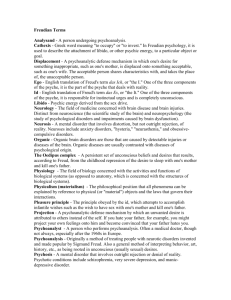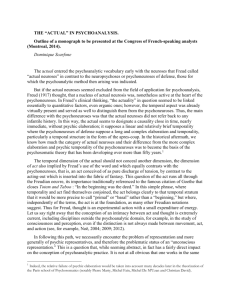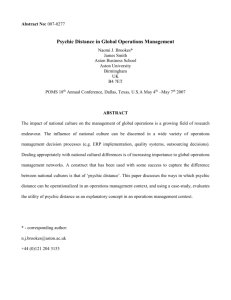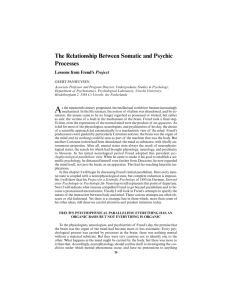Free Association Method in Psychoanalysis: Freud & Technique
advertisement
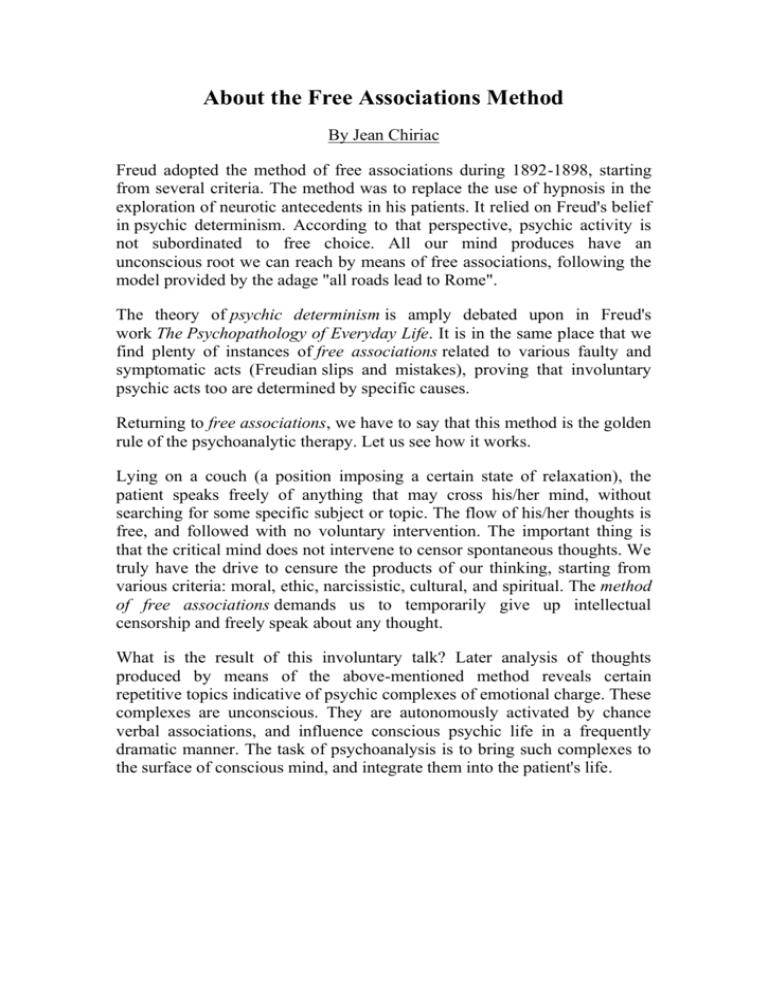
About the Free Associations Method By Jean Chiriac Freud adopted the method of free associations during 1892-1898, starting from several criteria. The method was to replace the use of hypnosis in the exploration of neurotic antecedents in his patients. It relied on Freud's belief in psychic determinism. According to that perspective, psychic activity is not subordinated to free choice. All our mind produces have an unconscious root we can reach by means of free associations, following the model provided by the adage "all roads lead to Rome". The theory of psychic determinism is amply debated upon in Freud's work The Psychopathology of Everyday Life. It is in the same place that we find plenty of instances of free associations related to various faulty and symptomatic acts (Freudian slips and mistakes), proving that involuntary psychic acts too are determined by specific causes. Returning to free associations, we have to say that this method is the golden rule of the psychoanalytic therapy. Let us see how it works. Lying on a couch (a position imposing a certain state of relaxation), the patient speaks freely of anything that may cross his/her mind, without searching for some specific subject or topic. The flow of his/her thoughts is free, and followed with no voluntary intervention. The important thing is that the critical mind does not intervene to censor spontaneous thoughts. We truly have the drive to censure the products of our thinking, starting from various criteria: moral, ethic, narcissistic, cultural, and spiritual. The method of free associations demands us to temporarily give up intellectual censorship and freely speak about any thought. What is the result of this involuntary talk? Later analysis of thoughts produced by means of the above-mentioned method reveals certain repetitive topics indicative of psychic complexes of emotional charge. These complexes are unconscious. They are autonomously activated by chance verbal associations, and influence conscious psychic life in a frequently dramatic manner. The task of psychoanalysis is to bring such complexes to the surface of conscious mind, and integrate them into the patient's life. Free Association A simple technique of psychodynamic therapy is free association in which a patient talks of whatever comes into their mind. This technique involves a therapist reading a list of words (e.g. mother, childhood etc.) and the patient immediately responds with the first word that comes to mind. It is hoped that fragments of repressed memories will emerge in the course of free association. Free association may not prove useful if the client shows resistance, and is reluctant to say what he or she is thinking. On the other hand, the presence of resistance (e.g. an excessively long pause) often provides a strong clue that the client is getting close to some important repressed idea in his or her thinking, and that further probing by the therapist is called for. Freud reported that his free associating patients occasionally experienced such an emotionally intense and vivid memory that they almost relived the experience. This is like a "flashback" from a war or a rape experience. Such a stressful memory, so real it feels like it is happening again, is called an abreaction. If such a disturbing memory occurred in therapy or with a supportive friend and one felt better--relieved or cleansed--later, it would be called a catharsis. Frequently, these intensely emotional experiences provided Freud a valuable insight into the patient's problems. Free association is a practice in psychoanalytic therapy in which a client is asked to freely share thoughts, random words, and anything else that comes to mind, regardless of how coherent or appropriate the thoughts are. The process was originally developed by Sigmund Freud, who claimed that it gave clients complete freedom to examine their thoughts without prompting or intervention by the therapist. Freud claimed that the technique helped prevent three common issues in therapy: 1. Transference – the process of transferring feelings one has for one person to a different person; 2. Projection – the process of projecting one’s own qualities onto someone else; 3. Resistance – the practice of blocking out certain feelings or memories. How Does Free Association Work? In traditional free association, the client is encouraged to verbalize or write all thoughts that come to mind. Free association is not a linear thought pattern. Rather, a person might produce an incoherent stream of words such as dog, red, mother, and scoot, or may jump randomly from one memory or emotion to another. The idea is that free association reveals associations and connections that might otherwise go uncovered and that clients may uncover repressed memories and emotions. Contemporary Free Association Freudian free association is fairly uncommon in therapy these days, even among neo-Freudians. Contemporary mental health practitioners might us a modified version of free association whereby they ask a client to recall all the memories associated with a particular event, share the first word that comes to mind after seeing a picture, or encourage a client to write down all of the thoughts she has during a particular time.





